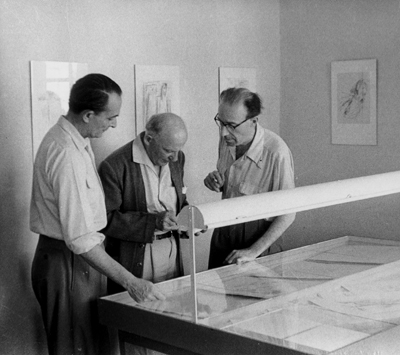Georges Duby : Léo Marchutz
Introduction au Catalogue de l’exposition d’œuvres de Léo Marchutz, qui s’est tenue à Aix-en-Provence, à la Galerie Tony Spinazzola, en juillet 1962
«On chercherait en vain un artiste aujourd’hui qui, plus exactement que Léo Marchutz, se situe dans le prolongement des recherches de Paul Cézanne. Affinité très intime, et native, qui poussa Marchutz à venir voici trente quatre ans s’établir à Châteaunoir, et à n’en plus bouger – mais qui n’a cessé de se nourrir, de s’enrichir, de s’approfondir par une méditation ininterrompue devant l’œuvre du Maître d’Aix, dans la lumière que celui-ci voulut traduire, face aux motifs dont il s’acharna à découvrir l’architecture essentielle. A tel point que pour commenter l’œuvre de Marchutz, il suffit de reprendre nombre des propos recueillis – et embellis, et souvent même sans doute inventés – par les amis de Paul Cézanne, et de dire par exemple, à propos de l’atmosphère, qu’elle «constitue l’enveloppe du tableau, en contribuant à sa synthèse».

Léo Marchutz (à droite) et Lucien Blanc (à gauche) visitant l'exposition
avec un journaliste
Avec une différence cependant, et majeure : il ne s’agit point de tableau. Léo Marchutz en effet a choisi voici longtemps de transcrire les émotions, les vibrations colorées et tout le spectacle du monde, par le concours du seul crayon lithographique. Ce renoncement, qui l’oblige à la plus extrême rigueur comme à la maîtrise parfaite d’un métier dont il a su ressusciter des façons oubliées, exprime sa nature la plus profonde. Elle est de dépouillement, de dénuement. Expulser peu à peu de l’image tout ce qui n’est pas essentiel – saisir par le seul trait nécessaire l’éclat d’un regard ou le battement d’une paupière lorsqu’il s’agit d’illustrer l’Evangile de Luc, et, devant un paysage, les rapports fondamentaux de masse, de lumière et de couleur entre l’air, la terre et le monument – parvenir enfin, au terme d’un cheminement patient jusqu’à l’extrême pureté. Ce qui touche, au cœur de l’art de Marchutz, c’est, animé par une rare exigence spirituelle, cette tenace volonté d’ascétisme.»
Georges Duby
English version
Introduction to the Catalogue for the Leo Marchutz show at the Tony Spinazzola Gallery in Aix-en-Provence, July, 1962.
I think one would look in vain today for an artist who, more than Leo Marchutz, might be established in the prolongation of Cezanne’s efforts. It was this intimate and natural affinity which provoked Marchutz, thirty-four hears ago, to settle at Chateaunoir, and not to move from there, never ceasing to replenish, enrich and deepen himself by an uninterrupted meditation, before the work of the Aix master in the light that the latter wanted to capture, in front of the motifs for which he persisted in discovering the essential architecture. This was so to such a degree that to comment on the work of Marchutz it suffices to repeat some statements gathered and embellished and doutless sometimes even invented by friends of Cezanne, and to say for example, concerning the atmosphere, that it constitutes the envelopment of the painting, while contributing to its synthesis.
There is however a difference, and a major one at that : it is not a question of paintings. Leo Marchutz chose, in effect, a long time ago to transcribe the emotion, the colored vibrations and the whole world spectacle, by means of the lithographic crayon alone. This renunciation, which obliges him to extreme strictness as to the perfect mastery of a craft of which he knew how to revive forgotten procedures expresses his most profound nature.
This nature is to deprive, to destitute. He expels little by little all which is not essential to the image. He grasps by the one necessary stroke the quickness of the flash of an eye when it is a question of illustrating the Gospel of St. Luke. He achieves in the same way, before a landscape, the fundamentals of mass, light and color between air, ground and buildings, and finally, at the end of a patiently followed road, arrives at an extreme purity. That which moves one, at the heart of Marchutz’s art, is a rare spiritual exigence, a strong will for asceticism.
Georges DUBY
---
